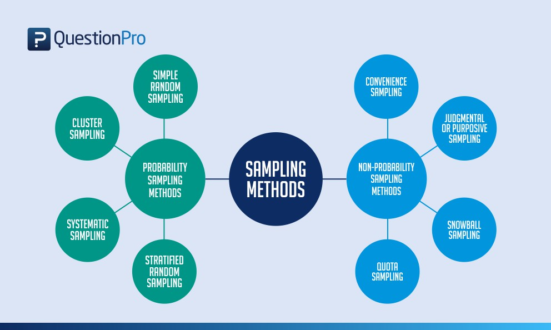Navigating interviews can be daunting, but you can significantly ease the journey with thorough preparation. Here are the five data science interview questions.
1. What is statistical sampling, and why is it important in data analysis?
Statistical sampling is selecting a subset of individuals, observations, or data points from a larger population to conclude the entire population. This technique is crucial in data analysis because it allows analysts to make inferences about a population’s characteristics without needing to examine every single data point, which can be impractical or impossible in many cases. By using proper sampling methods, data analysts can obtain accurate, representative insights while saving time and resources, reducing costs, and improving the efficiency of the data collection process.
Here are some examples of statistical sampling in data analysis:
- Surveys and Polls: In political polling, a small sample of voters is surveyed to predict the outcome of an election. Instead of interviewing millions of voters, a representative sample of a few thousand is used to estimate the opinions or voting intentions of the entire population.
- Quality Control in Manufacturing: In a factory, products are sampled from a production line to check for defects. Rather than inspecting every single item, a random sample is taken to estimate the overall quality of the batch, helping identify any issues without testing each product.
- Clinical Trials for New Medications: In medical research, a sample of patients is selected to participate in clinical trials to test the efficacy of a new drug. It would be infeasible to test the drug on the entire population, so a representative sample helps determine if the medication is effective and safe.
- Market Research: Companies conduct surveys or focus groups with a sample of customers to understand preferences and trends. For instance, a clothing retailer might survey a sample of shoppers to assess interest in a new product line rather than asking all customers.
- Environmental Studies: In studying the health of a lake, researchers may collect water samples from various points rather than testing the entire water body. The samples help estimate pollution levels or biodiversity, making the study more manageable.
These examples show how statistical sampling allows for making informed decisions and estimates without needing to examine every single element in the population.
2. What is a statistical population, and how does it differ from a sample?
A statistical population refers to the entire group of individuals, items, or data points that share a common characteristic and are of interest in a particular study. It represents the complete set of observations or measurements that the researcher aims to analyze. For example, all city residents, all manufactured items in a batch, or all students in a school could be considered a population, depending on the study’s focus.
Here’s the difference between a sample and a population presented in a tabular format:
| Aspect | Population | Sample |
|---|---|---|
| Definition | The entire group of individuals, items, or data points of interest. | A subset of the population selected for analysis. |
| Size | Typically large or the complete set. | Smaller than the population, often chosen to be manageable. |
| Representation | Includes every member of the group being studied. | Represents only a portion of the population. |
| Data Collection Cost | Usually more expensive and time-consuming. | Generally more affordable and quicker to collect. |
| Feasibility | A subset of the population was selected for analysis. | More practical and manageable for analysis. |
| Use in Analysis | Provides exact insights about the population characteristics. | Provides estimates or inferences about the population characteristics. |
| Example | All students in a university. | A group of 200 randomly selected students from that university. |
This table highlights how samples are used to study populations when analyzing the entire population isn’t feasible.
Check out the Data Science Interview Questions: Day 1
3. What are the types of sampling?
Here are the main types of sampling methods with examples for each:

1. Probability Sampling
In probability sampling, every member of the population has a known, non-zero chance of being selected. This approach aims to create a sample that is representative of the population.
- Simple Random Sampling: Each member of the population has an equal chance of being selected. For example, selecting 50 students at random from a university by drawing names from a hat.
- Systematic Sampling: Every nth member of the population is selected. For instance, surveying every 10th person on a list of customers.
- Stratified Sampling: The population is divided into distinct subgroups (strata) based on specific characteristics (e.g., age, gender), and a random sample is taken from each group. An example would be dividing a population into age groups (18-30, 31-45, etc.) and selecting a random sample from each.
- Cluster Sampling: The population is divided into clusters (usually based on location or other natural groupings), and entire clusters are randomly selected. For example, selecting a few schools at random from a district and surveying all students in those schools.
2. Non-Probability Sampling
In non-probability sampling, not all members of the population have a known or equal chance of being included. This method is often used when random sampling isn’t possible.
- Convenience Sampling: Samples are taken from a group that is conveniently accessible. For instance, surveying people who happen to be walking by a specific location.
- Judgmental/Purposive Sampling: The researcher selects samples based on their judgment about which members will be most useful or representative. For example, a researcher may choose experts in a field to interview for an in-depth study.
- Quota Sampling: The population is divided into subgroups, and samples are collected from each subgroup until a specified quota is met. For instance, surveying 100 men and 100 women to meet gender-based quotas.
- Snowball Sampling: Existing study subjects recruit future subjects from among their acquaintances. This is commonly used in research involving hard-to-reach populations, such as people with rare diseases.
These sampling methods allow researchers to choose the most appropriate technique based on study objectives, resource availability, and the nature of the population.
4. What is hypothesis testing?
Hypothesis testing is a statistical method used to make decisions about the validity of a claim (hypothesis) based on sample data. It involves formulating two competing hypotheses: the null hypothesis (H0), which states there is no effect or difference, and the alternative hypothesis (H1 or Ha), which states there is an effect or difference. Researchers collect data, perform statistical analysis, and decide whether to reject the null hypothesis based on a predetermined significance level (alpha).
5. What is the significance level (alpha)?
The significance level (alpha) is the threshold set by the researcher to determine whether to reject the null hypothesis. It represents the probability of making a Type I error. Commonly used significance levels are 0.05, 0.01, and 0.10, with 0.05 being the most widely accepted.
You can always return to Briefly Today and read all the latest happenings! Stay updated, Stay aware!
Do come back for more interview questions on Data Science…

